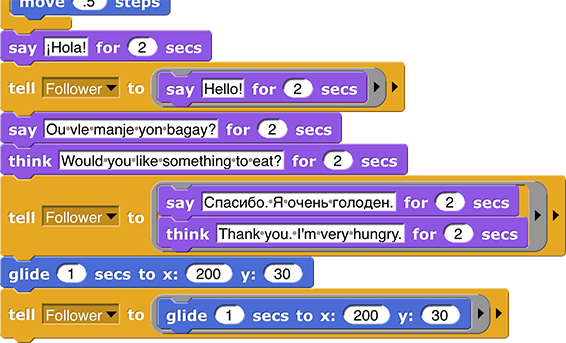-
Change Follower's code to point towards Leader only until it is touching Leader. (The following instructions show how.)
- Select Follower by clicking its button below the stage.
- Replace the
foreverblock with arepeat untilblock. -
Drag
 into the hexagonal space in the
into the hexagonal space in the repeat untilblock. Set it to repeat until it istouchingLeader.
Video needs to be rebuilt with new sprite names. --MF, 8/19/19Click for a video of this code being built.
- Do the same for Leader. Change its code to follow your mouse only until it is
touchingFollower. - Test your program to see if it does what you want:
- When you click
 , Leader (the gray one) should follow your mouse and Follower should keep turning to face Leader.
, Leader (the gray one) should follow your mouse and Follower should keep turning to face Leader. - If you bring Leader close enough to touch Follower, both sprites should stop moving.
- When you click
-
So far, Follower points toward Leader, but doesn't move toward it.
-
Add a line of code to Follower's script so that it chases Leader. Here's the idea:
Fill the input slot in themoveblock with a small number so Follower doesn't catch Leader too quickly.
- What happens if the sprites are already touching? That is, what happens if you drag one sprite on top of the other and then click the green flag? Why?
- What happens if the input to
moveis 0?
AAP-2.K.5AAP-2.K.4Need to add some text about infinite loops, likeforeveron 1.3.6. --MF, 8/6/19When a program keeps doing the same thing and doesn't ever stop, it's called an infinite loop.
-
Add a line of code to Follower's script so that it chases Leader. Here's the idea:



